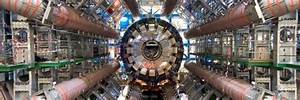Large Hadron Collider:

The world’s most powerful particle collider, the Large Hadron Collider (LHC), will begin smashing protons into each other at unprecedented levels of energy beginning July 5.
- It is expected to throw up evidence of “new physics” — or physics beyond the Standard Model of Particle Physics, which explains how the basic building blocks of matter interact, governed by four fundamental forces.
- The Large Hadron Collider is a giant, complex machine built to study particles that are the smallest known building blocks of all things.
- LHC is a 27-km-long track-loop buried 100m underground on the Swiss-French border.
- In its operational state, it fires two beams of protons almost at the speed of light in opposite directions inside a ring of superconducting electromagnets.
- The magnetic field created by the superconducting electromagnets keeps the protons in a tight beam and guides them along the way as they travel through beam pipes and finally collide.
- The particles are so tiny that the task of making them collide is akin to firing two needles 10 km apart with such precision that they meet halfway.
- Since the LHC’s powerful electromagnets carry almost as much current as a bolt of lightning, they must be kept chilled.
- It uses liquid helium to keep its critical components ultracold at minus 271.3 degrees Celsius, which is colder than interstellar space.




